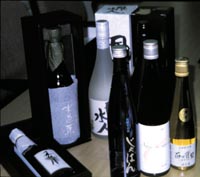Leisure |
Home | Archives | About | Media Links
November 1999
Sake to me!
Japanese alcoholic drink a
big hit in Hong Kong
By Alison Yeung
Another article from this beat:
Shuttlecock: A traditional sport in modern times
Sake, the most traditional alcoholic beverage in Japan, is now wearing a new face and enjoying an increasing popularity in Hong Kong. Generally speaking, there are two categories of sake: National Brands Sake and Premium sake. In Japan, National Brands sake dominates the market, but the sales of Premium sake have increased steadily in recent years. Premium sake, widely regarded as the finest sake in overall quality, came to the scene in the late 1980s. Sake first appeared in the third century as part of a Shinto religious festival. Villagers chewed rice chestnuts and millet and spat them out into a tub for fermentation. However, this technique is rarely practised now and the process of making Premium sake is more complicated. Only rice grown in specific areas can be used to make sake. Of the different kinds of rice used in the process, yamada nishiki is the most expensive one. The rice, which has bigger grains than cooking rice and contains high level of starch, is first polished. After the process of washing and steeping, the rice will be quickly moved to a koji room, where the starch in the rice is converted into sugar. Finally, yeast is be added to convert the sugar into alcohol. To observe the main characteristics of Premium sake, one should pay attention to the yeast used. Mr. Alex Chow, the director of a firm that imports sake, said, "The yeasts used are all carefully selected. For example, a special yeast which yields the taste of peaches and pears is chosen to make sake at Daishinsyu Sake Breweries." Basically there are three types of Premium sake: honjyozo, junmai and ginjo. Of the three, junmai is the most popular. Mr. Chow said that junmai was sweeter and can be easily accepted by both men and women. Also, the packaging of Premium sake is usually stylish, designed to attract young people and to distinguish itself from traditional sake labels. In order to popularize the product among young women, Premium sake with a lower percentage of alcohol has been introduced. Usually this kind of sake contains no more than 12 percent alcohol, while normal sake carries more than 15 percent. Whether the sake is chilled or heated largely depends on the season. In winter, a small glass of warm sake is preferred, while in summer, chilled sake is preferred. In some occasions, sake of low quality must be heated to remove strange flavours. But this is not the case for Premium sake. Mr. Chow suggested sake lovers should not heat Premium sake because it may destroy its aroma, flavours and structure. Regarding the popularity of Premium sake in Hong Kong, Mr. Chow is quite optimistic and confident about sales. According to Mr. Chow, more and more young people in Hong Kong are drinking sake. "With the increasing popularity of Japanese food in Hong Kong, people are beginning to get familiar with sake. The more they know, the larger the demand," said Mr. Chow. People's willingness to spend money on high quality products is another reason for the growth in sales of Premium sake. Complexity, one of the characteristics of Premium sake, also attracts local people. Ms Rachel Lam, a Year 1 student at Hong Kong Polytechnic University, said, "The taste of sake is rather complex. It was a bit sweet and a bit sour. When I swallowed it, I found it pretty dry." Sake is supposed to be tasted carefully and elegantly like wine. Mr. Chow said, "It would be ideal for Premium sake to be lightly chilled. It would not be a bad idea also to put one or two pieces of lime into the beverage." Apart from Japanese cuisine, Chinese dishes such as simmered tofu and shrimp are a good match with ginjo and junmai. Besides this, one should pay attention to the "sake meter" value shown on the bottle. A positive value means the sake is drier, while negative value means the sake is sweeter. The shape of glass helps people appreciate sake of good quality. A tulip-shaped glass is more effective in discerning quality than the traditional glass used by Japan's professional tasters. In order not to get drunk and not to waste the sake, those who imbibe should sip slowly. |
 Bottles of Premium sake. (Alison Yeung) |
Home | Archives | About | Media Links